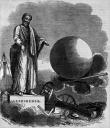The long-running British show about a crack team of archaeologists (and Baldrick) excavating a site in just a few days is coming to the States.
TIME TEAM, USA (w.t.) will take viewers into scientific digs, as experts uncover America’s rich history. The fast-paced series will intertwine high-tech geophysics, artists’ renditions of the past and computer reconstructions with more traditional archeological techniques. But the team of experts will have a mere 72 hours onsite to disinter artifacts and other significant materials; when time’s up, they’ll report what they’ve learned. Camera crews, tracking each step, will give the audience an archaeology-as-it-happens experience.
Some of the sites under consideration include the Indian Mounds of Mississippi and Skull Creek Dune in Oregon.
The US doesn’t provide quite the glamour of the UK when it comes to archaeological sites, though. No Roman forts or medieval cities. I wonder if they’re going to basically stick to pre-Columbian locations or if they might adapt to the newness of the culture and study more recent stuff.
There’s always the Spaniards. Spanish history in the United States goes way back and it’s often been overlooked in favor of the splashier British arrivistes.
Oh, I know! The Lost Colony of Roanoke! That would be a great thing to uncover in 72 hours after historians have spent hundreds of years trying to figure out what happened.


